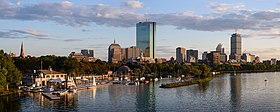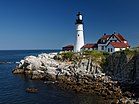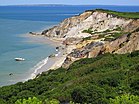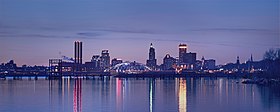**History of New England:**
– Inhabited by American Indian tribes like Abenakis, Mikmaq, and Mohegans.
– Explored by French, Dutch, and English traders starting in 1600.
– Named New England by John Smith in 1616.
– Establishment of Plymouth Colony in 1620 and dominance of Massachusetts Bay Colony by 1630.
– Various wars like the Pequot War, New England Confederation, and King Philip’s War.
– Formation of the Dominion of New England by King James II in 1686.
**Geography and Geology of New England:**
– Comprises six states in the Northeastern United States with diverse physical geography.
– Features coastal plains, rolling hills, mountains, and valleys.
– Glacial landforms shaping hills, mountains, and coastline.
– Part of the New England province with the Appalachian Mountains.
– Important valleys like Champlain, Connecticut River, and Merrimack Valley.
– Mount Washington in New Hampshire known for severe weather.
**Government and Economy of New England:**
– Each state subdivided into small municipalities known as towns.
– Strong cultural identity and a diverse economy combining agrarian life with industry.
– Role in the Industrial Revolution with a focus on the Blackstone and Merrimack river valleys.
– Immigrant influx due to religious tolerance and economic opportunities.
– Shift towards high-tech manufacturing, startups, and technology companies post-World War II.
– New England’s GDP was $1.1 trillion as of 2018.
**Demographics and Urban Centers in New England:**
– Population in 2020 was 15,116,205, with Massachusetts being the most populous state.
– Boston has the highest population density in the region.
– White Americans form 73.4% of the population, with Hispanic and Latino Americans as the largest minority group.
– Major urban centers like Boston, Worcester, Providence, Springfield, and Bridgeport.
– Boston excels in financial services and publishing, while Hartford is known for its insurance industry.
**Climate, Biodiversity, and Agriculture in New England:**
– Varied climate from humid continental to milder along the coast.
– Diverse terrestrial vertebrates in New England forests.
– Shifts in tree species diversity due to climate change.
– Agriculture challenges like rocky soil overcome in specific areas like aquaculture in Maine and dairy farming in Vermont.
– Land-use changes impacting ecosystems and species diversity.
– New England known for leadership in education, medicine, and tourism.
New England is a region comprising six states in the Northeastern United States: Connecticut, Maine, Massachusetts, New Hampshire, Rhode Island, and Vermont. It is bordered by the state of New York to the west and by the Canadian provinces of New Brunswick to the northeast and Quebec to the north. The Gulf of Maine and Atlantic Ocean is to the east and southeast, and Long Island Sound is to the southwest. Boston is New England's largest city and the capital of Massachusetts. Greater Boston is the largest metropolitan area, with nearly a third of New England's population; this area includes Worcester, Massachusetts, the second-largest city in New England, Manchester, New Hampshire, the largest city in New Hampshire, and Providence, Rhode Island, the capital of and largest city in Rhode Island.
New England | |
|---|---|
|
Left-right from top: Boston skyline, Portland Head Light in Cape Elizabeth, the Presidential Range, Burlington skyline, Aquinnah, the Connecticut River valley, skyline of Providence | |
 Flag (unofficial) | |
| Motto(s): None official. "An Appeal to Heaven" and "Nunquam libertas gratior extat" (Latin for 'Never does liberty appear in a more gracious form') are common de facto mottos. | |
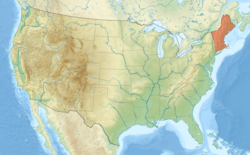 Location of New England (red) in the United States | |
 Location of New England (red) in North America | |
| Composition | |
| Largest metropolitan area | |
| Largest city | Boston |
| Area | |
| • Total | 71,987.59 sq mi (186,447.0 km2) |
| • Land | 62,688.4 sq mi (162,362 km2) |
| Population (2020) | |
| • Total | 15,116,205 |
| • Density | 210/sq mi (81/km2) |
| Demonym(s) | New Englander, Yankee, Novanglian, Novanglican (archaic) |
| GDP | |
| • Total | $1.41 trillion (2023) |
| Dialects | New England English, New England French |
In 1620, the Pilgrims established Plymouth Colony, the second successful English settlement in British America after the Jamestown Settlement in the Colony of Virginia, founded in 1607. Ten years later, Puritans established Massachusetts Bay Colony north of Plymouth Colony. Over the next 126 years, people in the region fought in four French and Indian Wars until the English colonists and their Iroquois allies defeated the French and their Algonquian allies.
In the late 18th century, political leaders from the New England colonies initiated resistance to Britain's taxes without the consent of the colonists. Residents of Rhode Island captured and burned a British ship which was enforcing unpopular trade restrictions, and residents of Boston threw British tea into the harbor. Britain responded with a series of punitive laws stripping Massachusetts of self-government which the colonists called the "Intolerable Acts". These confrontations led to the first battles of the American Revolutionary War in 1775 and the expulsion of the British authorities from the region in spring 1776. The region played a prominent role in the movement to abolish slavery in the United States, and it was the first region of the U.S. transformed by the Industrial Revolution, initially centered on the Blackstone and Merrimack river valleys.
The physical geography of New England is diverse. Southeastern New England is covered by a narrow coastal plain, while the western and northern regions are dominated by the rolling hills and worn-down peaks of the northern end of the Appalachian Mountains. The Atlantic fall line lies close to the coast, which enabled numerous cities to take advantage of water power along the many rivers, such as the Connecticut River, which bisects the region from north to south.
Each state is generally subdivided into small municipalities known as towns, many of which are governed by town meetings. Unincorporated areas are practically nonexistent outside of Maine, and village-style governments common in other areas are limited to Vermont and Connecticut. New England is one of the U.S. Census Bureau's nine regional divisions and the only multi-state region with clear and consistent boundaries. It maintains a strong sense of cultural identity, although the terms of this identity are often contrasted, combining Puritanism with liberalism, agrarian life with industry, and isolation with immigration.

